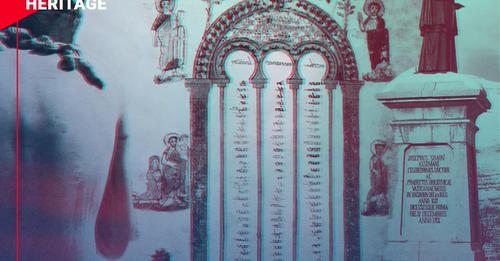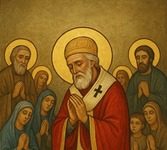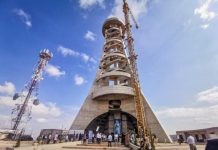The Trifora of the Lebanese House (I)
This article was originally published in French by Ici Beyrouth on March 26, 2022. The original can be found here.
By Dr. Amine Jules Iskandar Syriac Maronite Union-Tur Levnon
Soteriology in secular architecture
The Trifora, or triple bay, became emblematic of Lebanese architecture, and was used to adorn the Christian monuments of Phoenicia during the Byzantine period. It disappeared from the architectural landscape at the beginning of the Middle Ages to reappear later with the foundation of the Maronite College of Rome in 1584. That was the time of the Lebanese Renaissance which saw the reappearance of the slender columns surmounted by arcades similar to the miniatures of the sixth century Syriac manuscripts and of the twelfth century Syriac frescoes of Lebanon.
Lebanese Prince Fakhredin II the Great (1590-1635) exploited the Maronite Church’s relations with Tuscany, the Vatican and France in order to consolidate the independence of his principality. But he profited from it above all culturally since his reign coincided with the foundation of the Maronite College of Rome. His best advisers and ambassadors were the Maronite scholars who graduated from this college.

From among those scholars, we are particularly interested in Patriarch Estéphanos Douayhi (1630-1704) and Bishop Joseph Simon Assemani (1687-1768). The first carried out the oldest research on the history of the Maronites, on their architecture and their sacred art as well as on their liturgical music. The second was in charge of the Oriental Library of the Vatican, which he enriched considerably after several missions in the East. In particular, he carried out the first studies on the precious Maronite manuscripts of the Codex Rabulensis. These scholars thus brought to light the motif of the triple bay which had been lost for so long in the meanders of history.
In order to grasp the meaning of the Trifora in the Maronite tradition, one should refer to three Syriac sources: The writings of Patriarch Estéphanos Douayhi, the hymn of Hagia Sophia Cathedral in Edessa, and the miniatures of the Codex Rabulensis.
Source 1: Patriarch Estéphanos Douayhi
Let us consider first the text of Patriarch Estéphanos Douayhi who, quoting Saint John, writes in his Candelabra of the Holy Mysteries:
“He said that on each side, the doors were three in number, because the persons of the Holy Trinity are three, and in their name we have been commanded to baptize those who love him and believe in him.”
The patriarch thus explains to us at the end of the seventeenth century that symbolism and meaning are given to these triple bays which represent the Holy Trinity.
Source 2: The hymn of Saint Sophia of Edessa
Our second source is the Syriac hymn of Saint Sophia of Edessa, a cathedral erected in the sixth century by the architects Assaph and Addaï. Being contemporary with the architects, this hymn makes it possible to provide authentic interpretations. This can no longer be considered as a later explanation that does not correspond to the real intentions of the builders of the time. In the poetic spirit of the Syriac spirituality and language, the hymn of Edessa teaches us that “the choir has three windows whose brilliance represents the unique light of the Holy Trinity”.
At that time, it was customary in Byzantium to appoint two architects, one theoretician and the other practitioner, the relationship between material creation and its spiritual symbolism being of great importance. The Byzantine cupola concretizes the celestial vault or the Orbis Romanus (the universe). At its base, the forty windows embody the Integritas Saeculorum (the integrity of the centuries). Space and time are therefore summed up in what constitutes the covering of the cathedral. And for the microcosm to entirely represent the macrocosm, it only needs to add to this material universe, the spiritual world of the Beyond, thus appealing to the Holy Trinity represented by the triple bay.

Source 3: Codex Rabulensis
Our third Syriac source is the Maronite Gospel of Raboula, or Codex Rabulensis. This manuscript from the year 586 presents several examples of triple bays. This motif, inspired by the monuments of the time, became a prototype that ended up influencing the formal repertoire of sixth century iconographers. The similarities are striking between its details and the proportions of the columns, capitals and arcades which are found identically in the Lebanese architecture of the 19th century. The columns of the Lebanese triple bays have nothing to do with Greco-Roman proportions. Their finesse evokes those of the Codex Rabulensis and medieval Maronite frescoes such as those of Saint Theodore of Béhdidet.
In the Middle Ages, this model of arcades on thin columns remained quite widespread in the field of painting but not in architecture. Very common in the miniatures of the manuscripts and on the frescoes of churches, it will not make its reappearance in architecture until after the foundation of the Maronite College of Rome. At first, the arcades act as openwork galleries, like a second facade. They were not necessarily glazed. It was mainly in the nineteenth century that they acquired their refinement in a glazed version, centralized and concentrated on three bays, hence its Italian name of Trifora.
Lebanese architecture, whether secular or sacred, calls for a minimum of ornamentation. On top of that, its rare engraved designs are far from purely decorative; they carry meaning. Here and there appear protective crosses, sculpted birds identical to those that decorate the arcades of the Codex Rabulensis, snakes and above all lily flowers. When this plant is not carved in the stone of the arcade, it is in the woodwork of Gothic style that it multiplies. The triple bay, symbol of Trinity, most often completes its composition with the lily flower.

Dr Amine Jules Iskandar is an architect and the former president of the Syriac Maronite Union – Tur Levnon. Amine Jules Iskandar has written several articles on the Syriac Maronites, their language, culture, and history. You can follow him @Amineiskandar2
For the article in French see Ici Beyrouth. For the article in Spanish see Maronitas.org.
Also read from the same author:
About the origin of the Lebanese language part I and part II
Damour, gateway to totalitarianism
The Audacity to Question the Base
You have to know how to die to be able to live
A Port, a City, and a Mountain
Language in the Formation of Nation States
“KAFNO”: The Genocide on the Christians of Mount Lebanon during the First World War
The Trifora of the Lebanese House (II)
Soteriology in secular architecture
06/04/2022
This article was originally published in French by Ici Beyrouth on April 2, 2022. The original can be found here. Part I here
By Dr. Amine Jules Iskandar Syriac Maronite Union-Tur Levnon
The lily flower
The decorative theme most linked to the Trifora of Lebanese houses is without any doubt the hanging or standing lily flower. It adorns the arcades, sometimes even the capitals of so many of sacred and profane buildings found throughout all of Lebanon. If not incorporated in the stone section of the arcades, it is repeated tirelessly in the Gothic-inspired woodwork typical of Lebanese architecture. It survived in the joinery until the beginning of the twentieth century after which it faded away into the undulations of Art Nouveau, and later into the simplification of Art Deco. If the Trifora, or triple bay, with its three arcades, embodies “the unique light of the Holy Trinity”, it is worth exploring the deeper meaning of its typical lily flower.


The Armenian Gorzi Carpet
The standing lily flower is featured on the frame of an Armenian carpet in the Berlin Museum. It is known as the Gorzi Carpet and of great importance for the interpretation of the elements of Lebanese architecture since it constitutes a synthesis of the gate of Paradise symbolized by the triple bay of the Trinity.
This rug has a band of lilies and an Armenian inscription that places it in the year 1651 and which is made in dedication of Saint Hripsimé. It contains not only the arches and the lilies, but also the written proof of its Christian and sacred affiliation. For writer Volkmar Gantzhorn, who is interested in the identity and meaning of this motif, “it is clearly a question of lilies of the species Lilium Candidum, the white lily, a flower cultivated since antiquity and of Lebanese origin. It is a symbol of divine grace, and, in this case, it represents the grace of God at the Last Judgment”. It seems to have held as prominent a place as the Cedrus Libani in the Canaanite and later in the Christian repertoire.

The Gorzi Carpet has three arcades carried by a system of twin columns. According to Jules Leroy, this typical doubling of the columns, like the triple bays of Syriac manuscripts, is a symbolic evocation of perspective. It is therefore the representation of a church with three naves representing none other than the door to Paradise. This door is adorned with lilies, the symbol flower of divine grace. Volkmar Gantzhorn summarizes the message of this Gorzi Carpet as follows: “The church is the door to the hereafter and to Paradise. It is reached through the triumphal arch of faith with the help of God’s grace at the Last Judgement.”

Amshit Palace
A palace in Amshit brings together all these components in one. Here, the architect has reproduced in a very particular way the symbolic techniques of two-dimensional representations, characteristic of manuscripts and carpets, in a three-dimensional architectural art. He doubled the columns of the Trifora, clearly drawing inspiration from the motifs of iconographic painting. He also enriched the three arcades with a series of lily flowers. The facade of this palace thus presents the Trifora in the full glory of its soteriological message, i.e., the theology of salvation: because the doubled columns are those of the nave of the church, the door to the hereafter. The triple bay is the light of the Holy Trinity that leads to Paradise. And the lily flower represents the divine grace that makes us worthy of entry to the hereafter.

The Serpents of Hadat-Gebbé
An other house in Hadat-Gebbé, enriches the composition of its triple bay with a dove of the Holy Spirit, the lily flower, and serpents on the capitals of the columns. The snakes are two. They represent the knowledge of good and evil. It is them who dethroned Adam from Paradise.

In order to redeem himself, the Man-Adam is given recourse to the Holy Trinity (the Trifora), to its light, to the grace of God (the lily flower) and to the Holy Spirit (the dove). These two snakes are the same that we find on the epigraph of the Syriac Maronite church of Our-Lady-of-Semences (Zrou’) in Kphiphén. They are the fruits of evil, as opposed to the fruits of life, and are represented on the church by the body and blood of Christ the Redeemer.

The epigraph of Our Lady of Mayphouq
At the Monastery of Mayphouq, a phenomenon demonstrates that this soteriological approach was a conscious choice and in no way accidental. The spandrel of his Trifora from 1904 holds a Syriac inscription which deals with the theology of salvation:
“Lo purqono élo ba slivo, w lo hayé élo béh”
“There is no salvation but by the cross, and no life but by it”

The triple bay speaks an explicit message of salvation. Elsewhere, it evokes salvation by the light of the Holy Trinity and by the lily flower of divine grace in confrontation with the serpents. The epigraph therefore supports the symbols in their transmission of the soteriological message.
Another testimony confirms the attribution of a meaning to each of the elements and motifs. It concerns a nineteenth century photo showing the construction site of a house in Mount Lebanon. On closer inspection, we recognize an architect supervising the work. He is a priest. For the Church, whether Syriac Maronite, Greek or Armenian, was always, like in the West, the school, the university, and the hospital. It was the Church that initiated the arts and shaped identity at the same time as it formed liturgy and spirituality. Like their Church, the Lebanese were deeply imbued with the soteriological value that they expressed in both their secular and sacred architectures.

Dr Amine Jules Iskandar is an architect and the former president of the Syriac Maronite Union – Tur Levnon. Amine Jules Iskandar has written several articles on the Syriac Maronites, their language, culture, and history. You can follow him @Amineiskandar2
For the article in French see Ici Beyrouth. For the article in Spanish see Maronitas.org.
Also read from the same author:
About the origin of the Lebanese language part I and part II
Damour, gateway to totalitarianism
The Audacity to Question the Base
You have to know how to die to be able to live
A Port, a City, and a Mountain
Language in the Formation of Nation States
“KAFNO”: The Genocide on the Christians of Mount Lebanon during the First World War





















